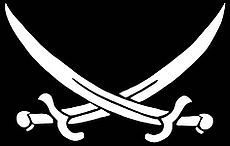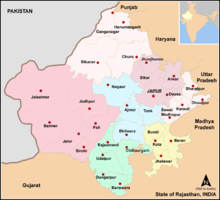- Sihag
-
Jat clan: Sihag 
Religion Hinduism Islam Varna Kshatriya Vansh Suryavansha, Nagavansha
Languages Bagri, Haryanvi, Rajasthani, Hindi Branches (Alternate names)
Asiagh (असिहाग) , Sehwag (सहवाग) ,
Siyag (सियाग) ,
Siag (सिअग) ,
Suhag (सुहाग) ,
Syag (स्याग) ,
Sehag (सेहाग) ,
Siyak (सियाक) ,
Sihak (सिहाक) ,
Syak (स्याक) ,
Sinhwag(सिन्ह्वाग),
Siwal (सिवाल) ,
Bolan (बोलन) ,
Chautala (चौटाला)
Ruled In Jangladesh(Rajasthan), Kot Khokhar (Mewar),
Pahulkot (Mewar)
Sihag (Hindi:सिहाग), Siyag (सियाग), Sehwag (सहवाग), or Asiagh (असिहाग) is a clan of Jat people found in Rajasthan, Haryana, Western Uttar Pradesh, Madhya Pradesh and Punjab region in India.[citation needed] According to Kautilya the people who depended on "Asii" (sword) for their living were known as Asiagh.[1][2]
Contents
Origin
Sihag originally is a clan of Jats which is an Indo-Aryan tribal group.[3]
The name Asiagh (Sihag) has been connected to the name of the Asii people by Thakur Deshraj,[4]
People belonging to Sihag gotra in Haryana claim common descent with Maans, Deshwals and Dalals.For about 30 generations they have looked upon "Dhana Rao Rathor" as their forefather.The genealogical tables prepared by the bards of these four gotras are incorrect because they called them the descendants of Dhanna Rathaur, when gotras like "Mann and Sihag" existed long before Dhanna Rao.[citation needed]
History
The Sihags are mentioned in the Puranas and the Mahabharat. A Sihag king offered a gift to Yudhisthira on his coronation.[citation needed]
Sihag's are also known as rulers in Rajasthan then known as Jangladesh. Kot Khokhar in Mewar has been the capital of the Sihag rulers. Pahulkot has also been their capital. Some names of these Sihag rulers were Vir Rana, Dhir Rana etc. They are mentioned in the manuscript of genealogical tables in the possession of Gorakh Singh.[citation needed]
Asirgarh(meaning Fort of Asiaghs) is a site of an ancient fort situated in Burhanpur district of Malwa region in Madhya Pradesh, India. It is of interest that ancient name of Hansi in Hisar district of Haryana was also "Asirgarh".
Rulers in Jangladesh
 Northern-most light pink coloured region is "Jangladesh". It includes the present-day districts of Bikaner, Churu, Ganganagar, and Hanumangarh.
Northern-most light pink coloured region is "Jangladesh". It includes the present-day districts of Bikaner, Churu, Ganganagar, and Hanumangarh.
"Sihag" clan is Known as one of the Jat cantons ruling "Jangladesh". Prior to 15th century, Rajasthan was called Jangladesh.[5]
Table of Jat Kingdoms in Jangladesh:
S.No. Name of Kingdom Name of King No. of villages Capital Names of districts 1. Sihag Chokha Singh 150 Sui Rawatsar, Baramsar, Purabsar Dandusar, Gandaisi 2. Beniwal Raisal Singh 150 Rasalana Bhukarka, Sanduri, Manoharpur, Kooi, Bae 3. Johiya Sher Singh 600 Bhurupal Jaitpur, Kumanu, Mahajan, Peepasar, Udasar 4. Punia Kanha Singh 300 Luddi Bhadra, Ajitpura, Sidhmukh, Rajgarh, Dadrewa, Sankhoo 5. Saharan Pula Singh 300 Bhadang Khejra, Phoglo, Buchawas, Sui, Badnu, Sirsila 6. Godara Pandu Singh 700 Shekhsar Shekhsar, Pundrasar, Gusainsar (Bada), Gharsisar, Garibdesar, Rungaysar, Kalu 7. Kaswan Kanwarpal Singh 100 Sidhmukh Out of total 2670 villages in the Jangladesh, 2200 villages were under the rule of Jat people.[6] It was ruled by their own chiefs and largely governed by their own customary law.[6] Each kingdom bore the name of the community, and was subdivided into districts.It is said about Jat territories that Saat Patti Sattavan Majh (means seven long and fifty-seven small territories).[7] At every stage of invasion to India the foreign invaders had to encounter with the Jats of this region. At what period the Jat people established themselves in the Indian desert is not known. By the 4th century they had spread up to Punjab in India.[8]
Sihag Jats were rulers in North Jangladesh prior to the rule of Rathores. Jangladesh coincided with the princely state of Bikaner in Rajasthan. When Rathores under the leadership of Bika and Kandal were spreading their rule in Jangladesh, At that time about 150 villages were under the rule of Sihag Jats. "Chokha Singh Sihag" was their king and their capital was "Sui (Sihaggoti)".It is 12 mile north-east to Shekhsar in Lunkaransar district. Rawatsar, Devasar, Biramsar, Moteir, Dandusar and Gandeli were other famous towns in their state.There another capital was "Pallu" which is nearby Sui in Nohar district. It is said that earlier its name was Kot Kiloor which afterwards was renamed on the name of Pallu, the daughter of Sihag king.[9][10]
Chokha Singh Sihag had war with Rathores but the Godara Jats and Delhi Sultanate had aligned with Rathores due to which sihag's faced a defeat. Rathores had established good relations with the Delhi Muslim rulers and became powerful. The lack of harmony and coordination among other Jat rulers led to the defeat of Jat states in Rajasthan and established the Rathore Kingdom in 1488 AD.It has been known that even after defeat Sihag Jats didn't accepted Rathore's rule and hence were invited for conference. They were tricked by Rathors and made captive in the conference hall and ultimately burnt alive. The Jats claimed their right over the land which was under their possession, before the Rathores occupied it and this claim was inherited by their descendants, who used to divide the land among themselves for cultivation. In the early period of their conquest the Rathores could not exercise any definite claim on the land as landlords. However, it was possible only in the 17th century, due to internal rivalries among Jat people, Godaras surrendered.Later on most of Jat clans in Rajasthan had to accept Rathor's suzerainty in mughal times due to the rathores having made alliance with the mughals.[11][12][13][14][15]
Sihag's in tree protection movement
Maharaja Abhay Singh, Ruler of Marwar (Jodhpur) state wanted to fell green Khejri (Prosopis cineraria) trees at village Khejarli to burn lime for the construction of his new palace. Since, there was a lot of greenery in the Bishnoi villages even in the middle of Thar desert, they protested to protect the trees and 363 Bishnois were massacred in the process. Out of these martyrs 13 persons were from Sihag clan. This incidence is considered to be the origin of Chipko movement. It was on Tuesday 10th day of the bright fortnight of the month Bhadrapad (Indian lunar Calendar) in 1730 A.D. The brave Bishnoi lady Amrita Devi played a historical role in this incidence.
Gotra wise number of these martyrs was as under: Achara (1), Badaderi (1), Badiyani (1), Chotiya (1), Degipal (1), Dudan (1), Geela (1), Goyal (1), Janwar (1), Javalia (1), Juriya (1), Kalirani (1), Khavi (1), Khichar (1), Kupasiya (1), Lamba (1), Maal (1), Rinwa (1), Seegar (1) Tadi (1), Vaasu (1), Adeena (2), Bhadiawas (2), Bola (2), Jhangu (2), Manjhu (2), Punia (2), Thalod (2), Bhanwal (3), Burdak (3), Chahar (3), Dhatarwal (3), Potalia (3), Rahad (3), Siyol (3), Badiya (4), Dhayal (4), Isram (4), Karhwasra (4), Bhangarwas (5), Dukia (5), Khava (6), Khileri (6), Lol (6), Nain (6), Sahu (6), Sinwar (6), Dhaka (8), Dara (10), Dudi (10), Kaswan (10), Khod (10), Khokhar (10), Panwar (10), Sihag (13), Not clear (22), Jyani (15), Saran (18), Babal (22), Beniwal (25),
Folklore
Once Godara king had sent his messenger to King "Chokha Singh Sihag" of Jangladesh to irritate king and provoke him to fight. So, that messenger went to Devasar village near Pallu. There is a pond in Devasar village where Chokha Singh ji used to take bath and meditated on its shore. Chokha Singh was meditating when that messenger reached him. The messenger reached him and said," I am a messenger of Godaras, give me some offerings". Chokha Singh replied, " If you want to have food, it will be prepared soon but I don't give offerings." As the messenger was ordered to say to Chokha Singh, he said,"What type of king you are?" On this, Chokha Singh took a handful of water and splashed it onto the messenger. Chokha Singh said," Take this and go away". But the messenger was astonished on seeing that the water had turned into gold Ashrafis. When the messenger returned to Godara king, he told them:-
There's an old tale famous about Pallu (capital of Sihag's) in Rajasthan that, once there was a Jat King named Mungamdhadka. He married his daughter Pallu to Sahib named prince of Delhi but internally he didn't want to. Therefore he gave venom to Sahib in lunch who afterwords died in Delhi fort. After some time he guided his son for investigating whether Sahib is alive or dead but ironically Pallu herself killed her brother in anger. After this Jat said -
- "जावै सो आवै नहीं, यो ही बड़ो हिलूर (फितूर)।
- के गिटगी पल्लू पापणी, के गिटगो कोट किलूर ।।"[17]
Mention by Megasthenes
Asiagh is one of the Jat clans as described by Megasthenes. He was an ambassador of Seleucus I of Syria to the court of Sandrocottus (Chandragupta Maurya) of India, in Pataliputra[18]
According to Megasthenes at that time Asiagh Jats were inhabited in Salt Range northern Punjab region known as Amanda.
:23.Then succeeds a level tract of country known by the general name of Amanda - The Peucolaitae, Arsagalitae (Asiagh), Geretae (Jat), Asoi (Asiagh) - Whereof the tribes are four in number.[19][20]
Notable Sihags
- Virender Sehwag[21][22]
- Chaudhary Devi Lal[23][24][25]
- Om Prakash Chautala[23][24][25]
- Ajay Singh Chautala
- Ch.Ram Singh Sihag Suchan Sirsa Haryana
Sihag umed parkash %ch. Ram Singh Sihag vpo dhani chRam Singh Sihag suchan
External links
References
- ^ Dr Mahendra Singh Arya, Dharmpal Singh Dudee, Kishan Singh Faujdar & Vijendra Singh Narwar: Ādhunik Jat Itihasa (The modern history of Jats), Agra 1998, p.284
- ^ Dilip Singh Ahlawat: Jat viron ka Itihasa
- ^ B.S. Dhillon: History and Study of the Jats,ISBN 1-895603-02-1
- ^ Deshraj, Thakaur (1934). Jat Itihas (Hindi). Delhi: Maharaja Suraj Mal Smarak Shiksha Sansthan.
- ^ "Bikaner". http://www.rajasthantourism.gov.in/destinations/bikaner/bikaneroverview.htm. Retrieved 2007-09-08.[dead link]
- ^ a b Dashrath Sharma, Rajasthan through the ages, Jodhpur, 1966, Vol.I, p. 287-288
- ^ G.S.L.Devra, op. cit., Cf. Dayaldas ri Khyat, Part II, p. 7-10
- ^ Thakur Deshraj, Jat Itihas, 1934, p. 616-624
- ^ G.S.L.Devra, op. cit., Cf. Dayaldas ri Khyat, Part II, p. 7-10
- ^ Dudee, Dharmpal Singh; Mahendra Singh Arya,Kishan Singh Faujdar & Vijendra Singh Narwar (1998). (Adhunik Jat Itihas) ( in Hindi) (The modern history of Jats). Agra: Jaypal Agencies.
- ^ Ibid, p.203
- ^ G.S.L. Devra, op. cit., 7-8, Cf. Dayaldas ri Khyat, part 2, p. 4-5
- ^ Jibraeil: "Position of Jats in Churu Region", The Jats - Vol. II, Ed Dr Vir Singh, Delhi, 2006, p. 223
- ^ a b चौधरी हरिश्चंद्र नैन, बीकानेर में जनजाति, प्रथम खंड, पेज 18
- ^ Dr Pema Ram, The Jats Vol. 3, ed. Dr Vir Singh,Originals, Delhi, 2007 p. 205-206
- ^ Deshraj, Thakur (1934). ठाकुर देशराज जाट इतिहास Jat Itihas. Delhi: Maharaja Suraj Mal Smarak Shiksha Sansthan.
- ^ मरू भारती, वर्ष 12, अंक 1
- ^ v,6
- ^ ., Megasthenes; E. A. Schwanbeck (1846). Indica. Sumptibus Pleimesii, bibliopolae (Original Oxford University) url=http://books.google.com/books?id=J1MOAAAAQAAJ&dq=megasthenes+indica&printsec=frontcover&source=bl&ots=J2gcSKuBO7&sig=ftZdMs9E4BMm8kKgI9Y2GiAilRQ&hl=en&ei=TM2fSsTuGYGx8Qa34NnbDw&sa=X&oi=book_result&ct=result&resnum=9#v=onepage&q=&f=false.
- ^ Dahlaquist, Allan (1996). Megasthenes and Indian Religion- Volume 11 of History and Culture Series. Motilal Banarsidass Publ.. p. 386. ISBN 8120813235. http://books.google.com/books?id=xp35-8gTRDkC&pg=PA130&dq=Yamuna&as_brr=0#v=onepage&q=Yamuna&f=false.
- ^ Tribune News Service (2004-04-16). "Verma’s gift for Sehwag". The Tribune. http://www.tribuneindia.com/2004/20040416/edit.htm#8. Retrieved 2006-04-16.
- ^ Tribune News Service (2002-10-19). "Top shot". The Tribune. http://www.tribuneindia.com/2002/20021019/windows/main1.htm. Retrieved 2006-02-11.
- ^ a b Devi Lal, the man of the masses
- ^ a b Devi lal Born to Ch. Lakh Ram Sihag
- ^ a b Ch. Devi Lal born in Sihag gotra family of landlords
Categories:- Jat
- Social groups of Rajasthan
- Social groups of Haryana
Wikimedia Foundation. 2010.
